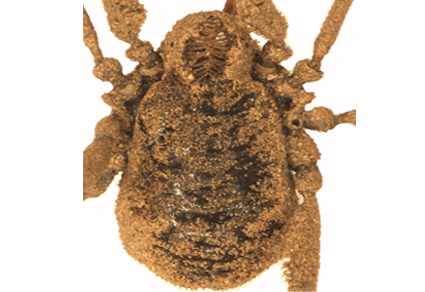Abstract
Dicranolasma ridvansahini sp. nov. (Opiliones: Dicranolasmatidae) is described from Nif mountain, İzmir, Türkiye on the basis of morphological and molecular characteristics. Detailed descriptions and diagnostic features of the new species, as well as illustration of relevant details are given. The new species was compared with some related species in the genus for morphological differences. Additionally, the 28S rRNA gene region was sequenced, and Bayesian Inference (BI) phylogenetic trees were constructed to clarify the species’ evolutionary relationships.
References
- Bayram, A. & Öcal, İ.Ç. (2007) A new record for the harvest spider fauna of Turkey: Dicranolasma giljarovi Silhavy, 1966 (Opilionida, Dicranolasmatidae). Turkish Journal of Zoology, 31 (1), 9–12.
- Bayram, A., Çorak, İ., Danışman, T., Sancak, Z. & Yiğit, N. (2010) Checklist of the harvestmen of Turkey (Arachnida: Opiliones). Munis Entomology & Zoology, 5 (2), 563–585.
- Drummond, A.J. & Rambaut, A. (2007) BEAST: Bayesian evolutionary analysis by sampling trees. BMC Evolutionary Biology, 7, 1–8.
- Gruber, J. (1998) Beiträge zur Systematik der Gattung Dicranolasma (Arachnida: Opiliones, Dicranolasmatidae). I. Dicranolasma thracium Staręga und verwandte Formen aus Südosteuropa und Südwestasien. Annalen des Naturhistorischen Museums in Wien. Serie B für Botanik und Zoologie, 100B, 489–537.
- Hedin, M. & Bond, J.E. (2006) Molecular phylogenetics of the spider infraorder Mygalomorphae using nuclear rRNA genes (18S and 28S): conflict and agreement with the current system of classification. Molecular Phylogenetics and Evolution, 41 (2), 454–471.
- Kumar, S., Stecher, G., Li, M., Knyaz, C. & Tamura, K. (2018) MEGA X: molecular evolutionary genetics analysis across computing platforms. Molecular Biology and Evolution, 35 (6), 1547–1549.
- Kunt, K.B., Elverici, M., Yağmur, E.A. & Özkütük, R.S. (2019) Kut gen. nov., a new troglomorphic spider genus from Turkey (Araneae, Dysderidae). Subterranean Biology, 32, 95–109.
- Kurt, K., Erman, Ö.K., Demir, H. & Seyyar, O. (2010) The Turkish harvestmen (Opiliones) with zoogeographical remarks. Serket, 12 (2), 33–44.
- Kurt, K. (2014) Updated checklist of harvestmen (Arachnida: Opiliones) in Turkey. Archives of biological sciences, 66 (4), 1617–1631.
- Kurt, P., Kurt, K. & Erdek, M. (2024) Determination of phylogenetic relationships of two species of Phalangium (Opiliones: Phalangiidae) by using 28S rRNA region. Biological Diversity and Conservation, 17 (3), 262–266.
- Kury, A.B., Kury, I.S. & De Oliveira, A.B.R. (2024) Checklists of extant harvestman (Arachnida: Opiliones) species for all the countries of the world. Zootaxa, 5515 (1), 1–162.
- Kury, A.B., Mendes, A.C., Cardoso, L., Kury, M.S., Granado, A.de A., Giribet, G., Cruz-López, J.A., Longhorn, S.J., Medrano, M., Oliveira, A.B.R. de, Kury, I.S. & Souza-Kury, M.A. (2023) World Catalogue of Opiliones. WCO-Lite. Version 2.5.1. Available from: https://wcolite.com/ (accessed 17 September 2024)
- López, H. & Oromí, P. (2010) A type of trap for sampling the mesovoid shallow substratum (MSS) fauna. Speleobiology Notes, 2, 7–11.
- Martens, J. (1965) Zoologische Aufsammlungen auf Kreta III. Opiliones. Annalen des Naturhistorischen Museums in Wien, 1965, 347–362.
- Martens, J. (1978) Weberknechte, Opiliones-Spinnentiere, Arachnida. Die Tierwelt Deutschlands, 64, 464 pp.
- Schönhofer, A.L. & Martens, J. (2010) Hidden Mediterranean diversity: Assessing species taxa by molecular phylogeny within the opilionid family Trogulidae (Arachnida, Opiliones). Molecular Phylogenetics and Evolution, 54 (1), 59–75.
- Šilhavý, V. (1956) Výsledky zoologické expedice Národního musea v Praze do Turecka (Resultata Expeditionis Zoologicae Musei Nationalis Pragae in Turicam). 19. Opiliones. Sborník Entomologického Oddělení Národního Musea v Praze, 30 (441), 31–39.
- Staręga, W.K. (1973) Beitrag zur Kenntnis der Weberknechte (Opiliones) des Nahen Ostens. Annales Zoologici, 30 (6), 129–153.
- Rambaut, A. (2014) FigTree. Version 1.4.2. A Graphical Viewer of Phylogenetic Trees. Available from: http://tree.bio.ed.ac.uk/software/figtree/ (accessed 26 January 2023)
- Rix, M.G., Harvey, M.S. & Roberts, J.D. (2008) Molecular phylogenetics of the spider family Micropholcommatidae (Arachnida: Araneae) using nuclear rRNA genes (18S and 28S). Molecular Phylogenetics and Evolution, 46 (3), 1031–1048.
- Vink, C.J., Dupérré, N. & McQuillan, B.N. (2011) The black headed jumping spider, Trite planiceps Simon, 1899 (Araneae: Salticidae): redescription including COI and paralogous 28S sequences. New Zealand Journal of Zoology, 38, 317–331.
- Vink, C.J., Dupérré, N. & Malumbres-Olarte, J. (2013) Periegopidae (Arachnida: Araneae). Fauna of New Zealand, 70, 1–41.
- Wang, Q., Li, S., Wang, R. & Paquin, P. (2008) Phylogeographic analysis of Pimoidae (Arachnida: Araneae) inferred from mitochondrial cytochrome c oxidase subunit I and nuclear 28S rRNA gene regions. Journal of Zoological Systematics and Evolutionary Research, 46 (2), 96–104.


